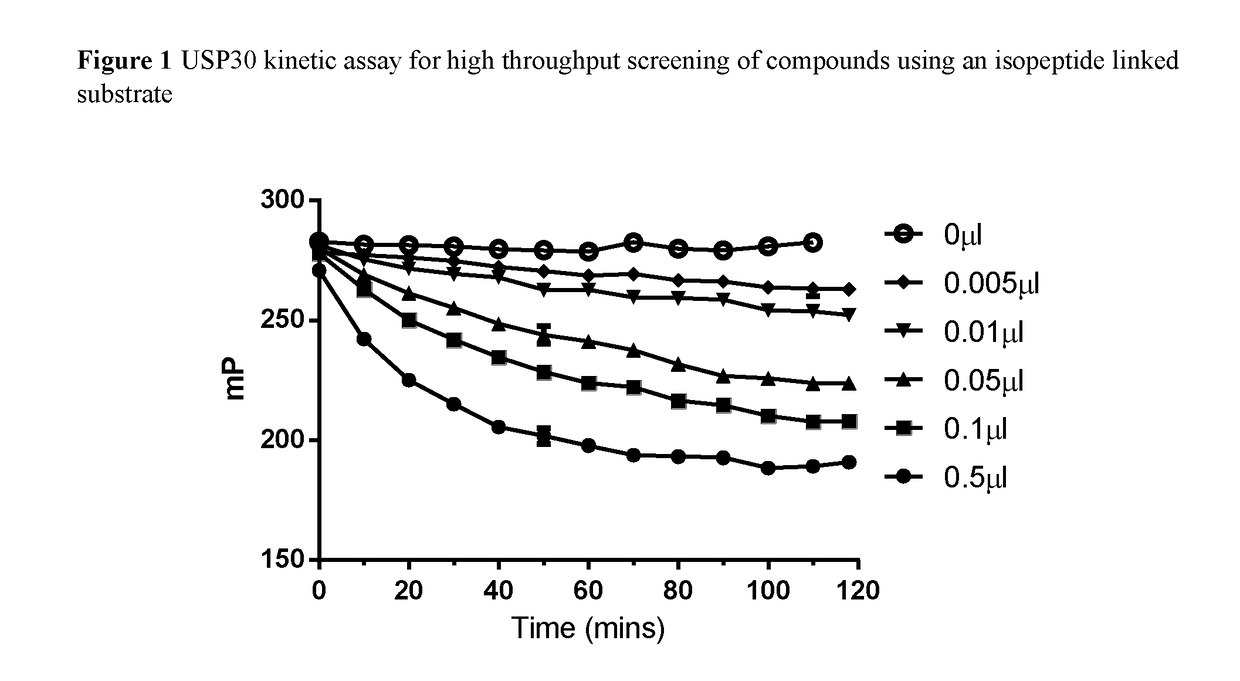Novel compounds
a technology of compounds and compounds, applied in the field of new compounds, can solve the problems of limited treatment with bortezomib, elusive deubiquitylating enzymes,
- Summary
- Abstract
- Description
- Claims
- Application Information
AI Technical Summary
Benefits of technology
Problems solved by technology
Method used
Image
Examples
example 1 1 -
Example 1 1-Cyano-N-ethyl-N-(4-phenylthiazol-2-yl)pyrrolidine-3-carboxamide
[0289]Synthesis According to General Scheme 1
[0290]Step a.
[0291]To a solution of 4-phenylthiazol-2-amine (CAS Number 2010-06-2; 5.00 g, 28.4 mmol) in THF (50 ml) was added TEA (8.3 ml, 59.9 mmol) at 0° C. Acetyl chloride (4.67 g, 59.6 mmol) was added dropwise to the reaction mixture at 0° C. The reaction was stirred at rt for 4 h. The resulting mixture was poured into water (50 ml) and extracted with EtOAc (3×150 ml). The combined organic layer was dried over Na2SO4, filtered and concentrated under reduced pressure. The residue was purified by column chromatography (25% EtOAc in hexane) yielding N-(4-phenylthiazol-2-yl) acetamide (3.00 g, 13.7 mmol). LCMS: Method C, 2.05, MS: ES+219.38; 1H NMR (400 MHz, DMSO-d6) δ ppm 12.27 (s, 1H), 7.89 (d, J=7.6 Hz, 2H), 7.61 (s, 1H), 7.43 (t, J=7.6 Hz, 2H), 7.32-7.34 (m, 1H), 2.16 (s, 3H).
[0292]Step b.
[0293]A solution of N-(4-phenylthiazol-2-yl)acetamide (2.00 g, 9.17 mmol...
example 2 1 -
Example 2 1-Cyano-N-ethyl-N-(5-phenylthiazol-2-yl)pyrrolidine-3
[0300]
[0301]The title compound was synthesised using a procedure similar to that described for Example 1. LCMS: Method C, 2.33 min, MS: ES+327.43; 1H NMR (400 MHz, CDCl3) δ ppm 7.72 (s, 1H), 7.58 (d, J=7.6 Hz, 2H), 7.40-7.44 (m, 2H), 7.33-7.35 (m, 1H), 4.30-4.37 (m, 2H), 3.70-3.79 (m, 3H), 3.49-3.57 (m, 2H), 2.33 (s, 2H), 1.21-1.36 (m, 3H).
example 3 (
S)-1-Cyano-N-methyl-N-(5-phenylthiazol-2-yl)pyrrolidine-3-carboxamide
[0302]Synthesis According to General Scheme 1
[0303]Step a.
[0304]A mixture of 2-amino-5-phenylthiazole (CAS Number 39136-63-5; 1.0 g, 5.68 mmol) and sodium formate (0.39 g, 5.68 mmol) in THF (5 ml) was heated to 45° C. Acetic anhydride (0.87 g, 8.52 mmol) was added and the reaction mixture was stirred at 45° C. for 1 h. The resulting mixture was cooled to rt, poured into saturated NaHCO3 solution (100 ml) and extracted with EtOAc (3×50 ml). The combined organic phase was separated, dried over Na2SO4, filtered and concentrated under reduced pressure yielding N-(5-phenylthiazol-2-yl)formamide (1.0 g, 4.90 mmol). This material was used for the next step without further purification. LCMS: Method C, 1.94 min, MS: ES−203.28.
[0305]Steps b-e.
[0306]The title compound was synthesised from the intermediate above using a procedure similar to that described for Example 1, steps b-e. LCMS: Method A, 4.54 min, MS: ES+313.10; 1H N...
PUM
 Login to View More
Login to View More Abstract
Description
Claims
Application Information
 Login to View More
Login to View More - R&D
- Intellectual Property
- Life Sciences
- Materials
- Tech Scout
- Unparalleled Data Quality
- Higher Quality Content
- 60% Fewer Hallucinations
Browse by: Latest US Patents, China's latest patents, Technical Efficacy Thesaurus, Application Domain, Technology Topic, Popular Technical Reports.
© 2025 PatSnap. All rights reserved.Legal|Privacy policy|Modern Slavery Act Transparency Statement|Sitemap|About US| Contact US: help@patsnap.com



